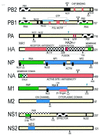Pattern of mutation in the genome of influenza A virus on adaptation to increased virulence in the mouse lung: identification of functional themes
- PMID: 11371620
- PMCID: PMC34447
- DOI: 10.1073/pnas.111165798
Pattern of mutation in the genome of influenza A virus on adaptation to increased virulence in the mouse lung: identification of functional themes
Abstract
The genetic basis for virulence in influenza virus is largely unknown. To explore the mutational basis for increased virulence in the lung, the H3N2 prototype clinical isolate, A/HK/1/68, was adapted to the mouse. Genomic sequencing provided the first demonstration, to our knowledge, that a group of 11 mutations can convert an avirulent virus to a virulent variant that can kill at a minimal dose. Thirteen of the 14 amino acid substitutions (93%) detected among clonal isolates were likely instrumental in adaptation because of their positive selection, location in functional regions, and/or independent occurrence in other virulent influenza viruses. Mutations in virulent variants repeatedly involved nuclear localization signals and sites of protein and RNA interaction, implicating them as novel modulators of virulence. Mouse-adapted variants with the same hemagglutinin mutations possessed different pH optima of fusion, indicating that fusion activity of hemagglutinin can be modulated by other viral genes. Experimental adaptation resulted in the selection of three mutations that were in common with the virulent human H5N1 isolate A/HK/156/97 and that may be instrumental in its extreme virulence. Analysis of viral adaptation by serial passage appears to provide the identification of biologically relevant mutations.
Figures




References
-
- Subbarao K, Klimov A, Katz J, Regnery H, Lim W, Hall H, Perdue M, Swayne D, Bender C, Huang J. Science. 1998;279:393–396. - PubMed
Publication types
MeSH terms
Substances
Associated data
- Actions
- Actions
- Actions
- Actions
- Actions
- Actions
- Actions
- Actions
- Actions
- Actions
- Actions
- Actions
- Actions
- Actions
- Actions
- Actions
- Actions
- Actions
- Actions
- Actions
- Actions
- Actions
- Actions
- Actions
- Actions
- Actions
- Actions
- Actions
- Actions
- Actions
- Actions
- Actions
- Actions
- Actions
- Actions
- Actions
- Actions
LinkOut - more resources
Full Text Sources
Other Literature Sources

